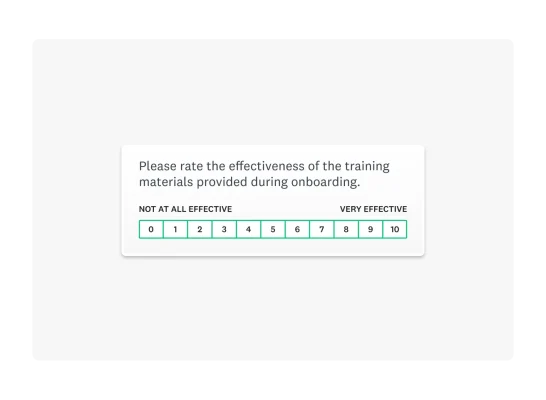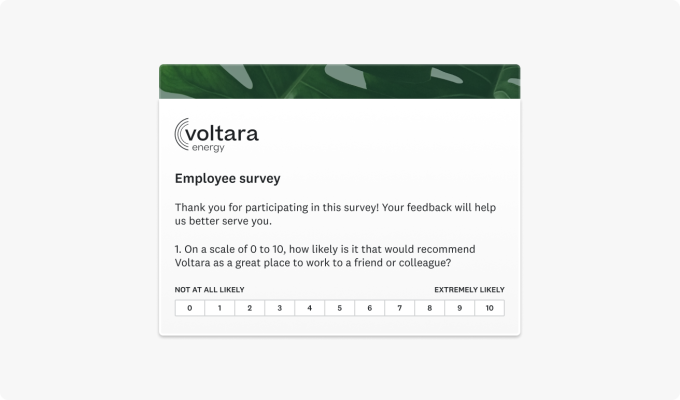30 effective onboarding survey questions for new hires
Discover the best onboarding survey questions to enhance new hire engagement and retention. Build effective onboarding surveys and improve the onboarding process.

Onboarding is crucial for integrating a new hire into your organization. A positive onboarding experience fosters job satisfaction, employee engagement, and long-term success by creating a sense of belonging and boosting performance.
Onboarding surveys are invaluable tools for gathering employee onboarding feedback. They highlight new hires' perceptions, identify program strengths, and pinpoint improvement areas. Analyzing this feedback helps HR to make informed adjustments, enhancing the employee experience at every touchpoint.
Read on to learn how to create an effective onboarding survey.
What is an onboarding survey?
An onboarding survey is a human resources tool for collecting feedback on new hires' experiences within an organization.
HR professionals can use onboarding surveys to identify communication difficulties, knowledge gaps, and engagement issues. Identifying friction points promptly allows you to employ solutions that improve the employee experience and retention.
Related reading: How to start an employee onboarding program
30+ examples of onboarding survey questions

Pre-onboarding experience
HR professionals use pre-onboarding survey questions to document contact information, role details, and technology loans. Managers typically complete pre-onboarding surveys, not new employees.
These surveys will include fields for:
- Employee name
- Preferred email
- Supervisor name
- Supervisor email
- Start date
- Department
- Hardware distributed
- Software installed
Customize your own pre-onboarding survey with our Employee Onboarding Checklist Form Template.
Engagement experience
Employee engagement describes the extent to which employees feel valued and involved at work. It's a strong indicator of employee satisfaction and retention.
New employees lack experience in your organization; however, this is an excellent opportunity to establish procedures that promote positive future employee engagement.
- Do you know who to go to for questions about the following topics?
- Do you have regular 1-on-1 meetings set up with your manager?
- Is your workload increasing too quickly, too slowly, or at the right pace?
First-week questions
You can have the greatest impact during the first week. Employee sentiment is mostly positive, and if there is an error or gap in your onboarding program, you can demonstrate a commitment to employee happiness.
- Prior to your first day at work, did you feel you had received all the necessary information such as the schedule of the onboarding process?
- How are you feeling about the onboarding process so far?
- Do you have access to all of the IT systems needed to do your job?
- Have you completed the onboarding tasks? Select all that apply.
- Was your computer equipment ready when you arrived at the office on your first day?
Try our Week 1 Onboarding Check-In Survey Template to gather valuable insights from new team members.
Role clarity questions
When done effectively, your onboarding materials should equip employees to assume their responsibilities by the end of the process.
Consider using role clarity questions to identify any knowledge gaps. These questions highlight additional training opportunities and ensure employees feel confident in their roles.
- Do you feel that your job responsibilities align with your expectations based on the job description?
- To what extent do you understand the metrics used to evaluate your work?
- Do you feel you have the training and resources you need to succeed in your role?
Culture fit questions
Company culture is the cohesive force that unites an organization. New employees need to understand your company’s culture to integrate with it properly.
- To what extent do you understand the organization's culture, values, and goals?
- Outside of your manager, do you have someone to go to for advice at work?
- How valued do you feel at work by your co-workers and team leaders?
- Have you had meet-and-greets with your new colleagues?
Why onboarding surveys are important
Employees are a business's most important asset. While they bring a unique skill set, it's up to you to set them up with the right tools and knowledge to succeed.
Employee onboarding surveys help you measure the impact of your orientation process and upgrade for future onboarding.
Your onboarding survey can also help you:
Enhance employee experience
You need to understand a new hire’s perception of your organization. While they may have fewer interactions than veteran employees, their early experience impacts the rest of their tenure with your organization.
The employee experience is crucial for a successful business, affecting everything from brand reputation to the quality of future hires and their engagement (more on that soon).
A strong company culture that fosters a sense of purpose and development attracts talented and high-performing employees (who will also go through your onboarding training)! In turn, employees create innovative solutions that drive company revenue, profits, and market share.
Insights gained from onboarding surveys ensure the onboarding process aligns with the broader employee journey and employer brand.
Boost employee engagement
An effective onboarding experience positively influences employee engagement. Harvard Business Review found that organizations that invest in employee onboarding programs can see 62% greater productivity among new hires and experience 50% greater employee retention.
Engaged employees are more productive because they feel connected to their work and their organization’s goals. Their strong connection to the organization makes them proactive, going beyond their job description. As a result, engaged employees strengthen a company and are more likely to stay with it.
Refine the onboarding experience
Onboarding surveys solicit feedback directly from new hires and pinpoint specific aspects of the onboarding process that may require refinement.
Organizations can tailor their onboarding experiences to meet new employees' needs and expectations by streamlining administrative procedures, providing clearer communication, or adjusting training methods.
You can even leverage employee pulse surveys to follow up with your new hires at set intervals (e.g., 30 days, 60 days, and 90 days) to see if they still feel the onboarding process adequately prepared them for their job.
Related reading: How (and why) to collect employee onboarding feedback

Measure success and identify challenges
Onboarding surveys offer quantifiable metrics to measure the success of onboarding initiatives. From satisfaction scores to specific performance indicators, companies and departments can gauge the effectiveness of their onboarding strategies.
Simultaneously, surveys help identify potential challenges, sparking proactive measures to address issues before they impact the overall employee experience.
Onboarding surveys are a win-win for your new hires and company. Try our easy-to-use onboarding template for free.
How to build an effective onboarding survey (10 easy steps)

1. Define your goals
Start by defining your survey objectives. Your objectives provide direction and help respondents understand the survey’s purpose.
These objectives should align with your overarching business goals to ensure the effectiveness of your research. They guide the direction of your inquiry and provide relevance to the insights you gather.
2. Choose the right questions
Plan your onboarding survey questions carefully and get the most applicable answers you can act on.
Consider the following questions to jumpstart your survey:
- How valuable was the new hire onboarding at our company?
- Before your first day at work, did you receive all the necessary information (such as the schedule of the onboarding process)?
- How clear was the information presented during the onboarding?
- Should onboarding have been longer, shorter, or was it just right?
- Was your computer equipment ready when you arrived at the office on your first day?
3. Keep it short and simple
Employee onboarding is an inundation of information, paperwork, and meet and greets. Support new hires by not adding to onboarding stress with a complicated survey.
4. Prioritize anonymity and confidentiality
Just as you are concerned with the impression your onboarding experience makes, new hires are also concerned about their presence. For this reason, new hires may hesitate to provide candid feedback for fear of repercussions.
An anonymous and confidential survey gives new hires the confidence to express their honest thoughts. Anonymous surveys do not collect information that can identify a new hire, such as an employee ID number or their name.
Confidential surveys ensure that feedback received remains private. Only survey administrators can view and follow up on survey responses.
5. Gather qualitative and quantitative feedback
Keep in mind that there are multiple ways to collect feedback, including close-ended and open-ended responses.
Close-ended questions don’t allow respondents to provide unique answers and include answer options such as multiple-choice, checkboxes, and sliders. Open-ended questions will uncover your respondents’ reasoning.
Both quantitative and qualitative responses can help you gain a well-rounded understanding of your new hires.
6. Customize and brand your onboarding survey
Customization lends credibility and trustworthiness to your survey. Put differently, a customized survey communicates that it's created specifically for your organization—the questions are thoughtful and tailored to your audience.
SurveyMonkey has several survey customization options, allowing you to create a personalized survey experience.
7. Reach out to various people for feedback
New hires are the most important people you should survey about your onboarding experience. They have fresh viewpoints that directly influence your onboarding program’s efficacy.
In addition to new hires, you should survey employees involved in the onboarding process, including managers, team leads, and department heads.
8. Send onboarding surveys at regular intervals
Utilize feedback from your onboarding programs to continuously improve the onboarding experience for future hires.
Implement regular surveys at intervals such as 30, 60, and 90 days (or customized intervals that align with your organizational needs) to evaluate the progress of new employees, ensuring they have all the essential resources for a successful start.
9. Measure your impact
Onboarding surveys are a unique opportunity to receive candid and constructive feedback. However, it’s not enough to just collect employee feedback. You’ll need to act and measure your impact to create tangible results.
Employee experience KPIs include employee retention and employee Net Promoter Score (eNPS®). Survey new hires at the beginning of their tenure to set a KPI baseline. Throughout the onboarding process—about 12 months—survey your new hire cohort to analyze how their employee experience and eNPS changes.
Measuring and monitoring new hires' employee experience can help you as you continue to update the onboarding experience for later cohorts.
10. Improve your survey continuously
As your company grows, your onboarding process must evolve to accommodate the unique needs of all workers. Regularly sending out an onboarding survey will help you identify areas for improvement and common pain points your new hires face.
As your onboarding process improves, so should your onboarding survey. Update it continuously to ensure that your changes have the most impact.
3 tips for making your onboarding survey engaging
In addition to writing the perfect onboarding survey questions, you can take extra steps to create an onboarding feedback survey that engages new hires and improves data quality.
- Add visuals or images to improve engagement. Few things will ruin your completion rates like large blocks of text. Add visuals to illustrate your survey questions to break up text.
- Use relatable language that aligns with company culture. Before filling your survey with organization-specific jargon, consider your new hires' onboarding stage. Have your training sessions covered your 'synergy framework' or extensive tech stack? It's a good idea to leave those questions to a time when they have all the vocabulary.
- Limit the survey length to maintain completion rates. The first few questions may be simple, but enthusiasm may wane as the survey continues. Refer to your objectives and choose a few questions related to your goal. Leave extra or follow-up questions for later surveys.
Build your onboarding survey with SurveyMonkey
Your employee onboarding program is vital to business success. Organizations can continuously refine their onboarding processes through targeted surveys, ensuring employees feel supported and engaged.
Employee onboarding feedback is invaluable for measuring employee experience and optimizing profitability. See how SurveyMonkey can help improve your new hire experience with our employee onboarding survey.
Get started today to gather feedback from your company’s newest hires.
Net Promoter, Net Promoter Score, and NPS are trademarks of Satmetrix Systems, Inc., Bain & Company, Inc., and Fred Reichheld.
Ready to get started?
Discover more resources

Attract, engage, and retain top talent with data-driven insights
Create powerful HR surveys with SurveyMonkey to gather feedback, boost engagement, and improve workplace culture. Streamline HR processes with customizable templates.

Work-life balance statistics for 2025
SurveyMonkey data shows work-life balance now outranks pay. Explore 2025 workplace trends, burnout drivers, and HR strategies for retention.

Side hustle trends for 2025: Data, statistics, and expert advice
2025 side hustle statistics and trends on why more Americans are turning to side gigs for survival and growth, what they earn, challenges, and advice.

SurveyMonkey research: 2025 Workplace Culture and Trends
Discover SurveyMonkey’s latest workplace culture trends with original data reports and employee experience research.